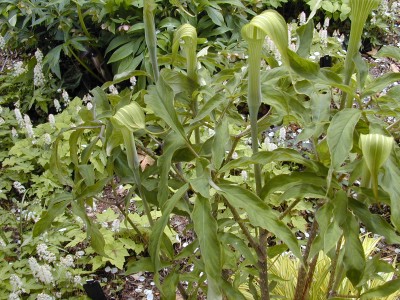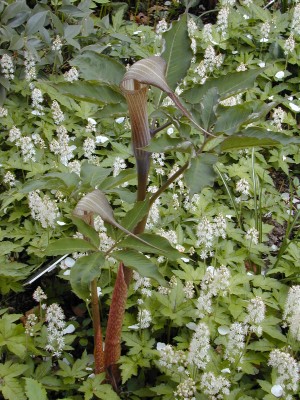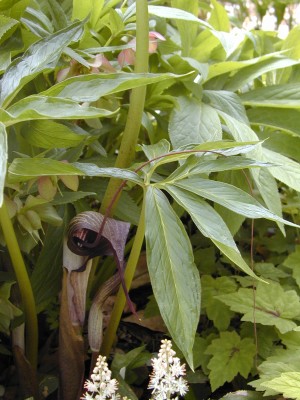Treasure Trove of Spring Ephemerals
At the Scott Arboretum many exciting spring flowering perennials are emerging from the ground. The Terry Shane Teaching Garden is a treasure trove of rare and choice spring ephemerals. In the local woods our native jack-in-the-pulpit, Arisaema triphyllum is quickly breaking ground with trilliums and mayapple, Pododphyllum peltatum. In the Shane Garden there are some stunning examples of the many exquisite species of the Asian jack-in-the-pulpits or cobra lilies.
Growing under the old tea crabapple are several Arisaema. The Japanese cobra lily, Arisaema ringens native to Japan, China and Korea is grown for both its shiny foliage, as well as its stout, cobra-like flower. The spathe or the “pulpit” is purple and white striped and the interior of the flower is a glossy purple. Towering above the other woodland plants is Arisaema tosanense which comes from the Shikoku Islands in Japan. Reaching approximately 30 inches tall the flowers extend above the foliage. The spathe is a translucent green with evenly spaced white stripes. The tip of the spathe extends over the tip of the flower giving it a graceful and elegant appearance.
We have two selections of Arisaema kishidae. One form has a plain leaf while the other has a silver splotched or “patterned” leaf. This species reaches about twelve inches tall. The spathe has beautiful white and burgundy striping. Growing in close proximity is Arisaema thunbergii subsp. urashima. The leaves reach 15 inches tall but the tight flower head is nestled much closer to the ground. The stout, nearly purple black spathe has a long and curling tip which extends up to 18 inches from the tip of the flower like a long wiry snake.
At the end of the Cunningham house under Stewartia pseudocamellia is the piece de resistance of the jack-in-the-pulpits, Arisaema sikkokianum. The burgundy and white striped spathe twists above the spadix or “jack” which is a striking pure, alabaster white. This, without a doubt, is the most stunning of all the Arisaema.
The Arisaema generally grow best in dappled to full shade in a soil rich in organic matter which does not dry out in periods of drought.








No Comments